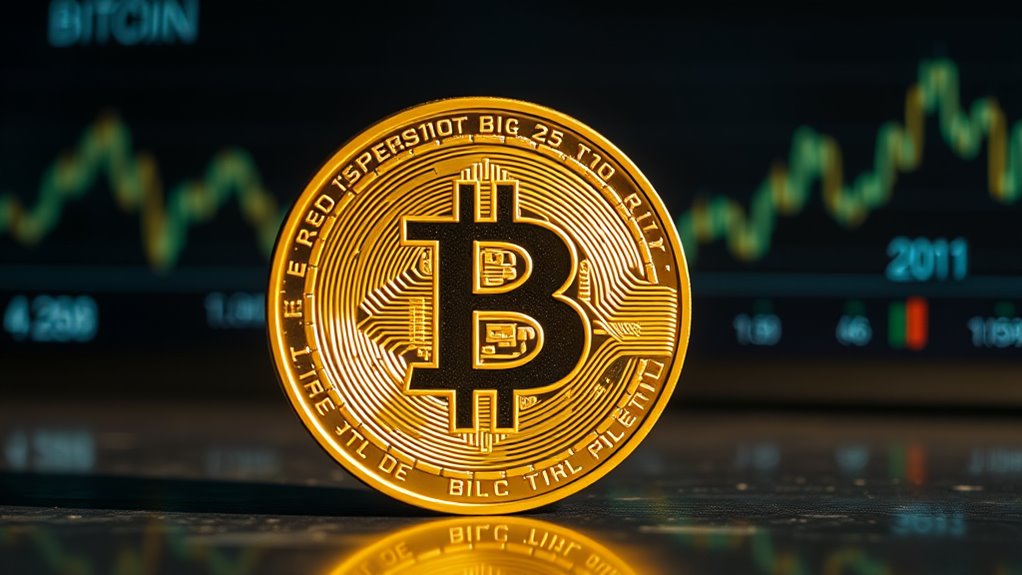
What Is Bitcoin: Why It’S the Future of Money
Bitcoin is a decentralized digital currency created in 2008 by the pseudonymous Satoshi Nakamoto. It operates on blockchain technology without central authority, enabling peer-to-peer transactions with lower fees than traditional banking systems. Bitcoin's fixed supply cap of 21 million coins creates scarcity similar to gold, potentially serving as a hedge against inflation. Its growing institutional adoption and resilience during economic uncertainty suggest Bitcoin may fundamentally transform global financial systems beyond conventional monetary structures.
Key Takeaways
- Bitcoin is a decentralized digital currency created in 2008 that eliminates intermediaries like banks while enabling peer-to-peer transactions globally.
- Unlike traditional fiat currencies, Bitcoin has a fixed supply cap of 21 million coins, creating scarcity that protects against inflation.
- Bitcoin transactions occur on a secure, transparent blockchain network maintained by miners who validate and record all activities.
- Growing institutional adoption and mainstream acceptance demonstrate Bitcoin's evolution from a niche technology to a legitimate financial instrument.
- Bitcoin offers financial inclusion for the unbanked, resistance to censorship, and potentially serves as a hedge against economic instability.
The Genesis of Bitcoin: Understanding Satoshi Nakamoto's Vision

Mystery shrouds the birth of Bitcoin, a revolutionary digital currency that emerged during one of the most challenging economic periods in recent history.
On October 31, 2008, an unknown entity using the pseudonym Satoshi Nakamoto published a white paper titled "Bitcoin: A Peer-to-Peer Electronic Cash System," laying the foundation for a decentralized financial network.
The 2008 financial crisis catalyzed Bitcoin's creation, highlighting systemic failures in traditional banking. Nakamoto's vision extended beyond creating digital money—it aimed to democratize finance by eliminating intermediaries like banks and governments.
Drawing inspiration from earlier concepts such as B-Money and Bit Gold, Bitcoin pioneered blockchain technology while emphasizing security through cryptography and transparency via a public ledger.
On January 3, 2009, the genesis block was mined, launching a financial revolution.
After establishing Bitcoin and guiding its early development, Nakamoto disappeared completely in 2011, leaving behind an enduring mystery about their true identity that continues to fascinate the cryptocurrency community.
How Bitcoin Works: Blockchain Technology Explained

The intricate design of blockchain technology forms the backbone of Bitcoin's revolutionary financial system. This technology operates as a decentralized, immutable ledger distributed across numerous computers worldwide.
Blockchain's elegant architecture anchors Bitcoin, functioning as an unalterable distributed ledger across global networks.
When a user initiates a Bitcoin transaction, it enters a queue in the memory pool. Miners then compile these transactions into blocks, solving complex mathematical puzzles to add them to the blockchain. Each block connects to the previous one through a unique hash, creating an unbreakable chain.
The network's security stems from its consensus mechanism, where nodes verify transactions and blocks to maintain data integrity. Transactions typically require five confirmations before being considered fully settled.
This system guarantees transparency while preserving pseudonymous privacy through cryptographic techniques, making Bitcoin's blockchain virtually tamper-proof and resistant to censorship. The blockchain concept has expanded beyond cryptocurrency to transform industries like supply chain management, healthcare, and voting systems through its ability to establish trust without central authorities.
Mining Process: How New Bitcoins Enter Circulation

Mining Bitcoin represents a computational race where participants compete to solve complex mathematical problems in exchange for newly minted cryptocurrency.
Using specialized hardware like ASICs, miners validate transactions and group them into a Merkle tree before attempting to find a valid hash by adjusting a value called the nonce.
The mining process serves multiple purposes: it secures the network through proof-of-work, prevents fraud by verifying transactions, and controls the supply of new Bitcoins entering circulation.
Miners receive both newly created Bitcoins and transaction fees as rewards for their efforts.
This energy-intensive process faces sustainability challenges, with mining operations distributed globally and often organized into pools to increase success probability.
Once all 21 million Bitcoins are mined, transaction fees will become miners' sole income source.
The consensus mechanism underlying Bitcoin mining ensures that all network participants agree on the validity of transactions without requiring a central authority.
Bitcoin's Limited Supply: The 21 Million Coin Cap

Unlike traditional currencies with unlimited printing potential, Bitcoin operates with a fixed cap of 21 million coins that can ever exist, creating an inherent scarcity similar to precious metals.
This scarcity is reinforced through "halving events" that occur approximately every four years, reducing the rate at which new bitcoins are generated and gradually slowing the supply growth.
The mathematical algorithm behind Bitcoin guarantees this supply limit cannot be breached, establishing a deflationary monetary system resistant to the inflation that typically erodes the value of government-issued currencies over time.
These halving events have historically correlated with significant price increases as the reduction in mining rewards creates additional scarcity in the market.
Scarcity Creates Digital Gold
Scarcity stands as the cornerstone of Bitcoin's identity as "digital gold," a concept rooted in its deliberately limited supply of 21 million coins. This finite cap creates value through basic economic principles—when supply is restricted while demand increases, price appreciation often follows.
The deflationary nature of Bitcoin contrasts sharply with traditional currencies that can be printed without limit.
- Bitcoin's scarcity is programmatically enforced, unlike gold which can be discovered or mined with advancing technology.
- Nearly 19.8 million BTC have already been mined, with less than 1.2 million remaining.
- This built-in scarcity fuels investor confidence in Bitcoin's long-term value proposition.
- Digital scarcity offers advantages over physical gold, including divisibility and ease of transfer.
- The psychological impact of known scarcity enhances Bitcoin's appeal as a store of value.
This principle of enforced scarcity has contributed significantly to Bitcoin's evolution from a niche digital asset to a recognized store of value in the global financial ecosystem.
Halving Events Impact Supply
The Bitcoin protocol features a built-in mechanism known as "halving" that directly reinforces its scarcity principle. This process occurs approximately every four years, reducing the reward miners receive for validating transactions by 50%.
These halving events systematically decrease the rate at which new bitcoins enter circulation, making the cryptocurrency increasingly scarce over time.
With a maximum supply capped at 21 million coins, each halving represents a significant milestone in Bitcoin's deflationary model. Historically, these events have preceded periods of increased market interest and price appreciation as the reduced supply meets steady or growing demand.
The 2024 halving is particularly significant due to increased institutional participation and the introduction of Bitcoin ETFs, potentially amplifying its market impact while encouraging miners to adopt more energy-efficient practices to maintain profitability.
Historical data shows that bull market cycles typically follow Bitcoin halving events, though past performance doesn't guarantee future results.
Mathematical Guarantee Prevents Inflation
Central to Bitcoin's revolutionary approach is its mathematically guaranteed maximum supply of 21 million coins, a fundamental constraint hardcoded into the cryptocurrency's protocol.
Unlike fiat currencies that can be printed at will by central banks, Bitcoin's supply is immutable and transparent, offering protection against inflation and currency devaluation.
This limited supply creates several important economic effects:
- Creates scarcity similar to precious metals like gold
- Prevents artificial inflation through excessive "money printing"
- Guarantees value preservation over time through deflationary design
- Requires consensus among the entire network to modify
- Provides predictable issuance that investors can rely upon
The cap's enforcement through decentralized nodes rather than central authorities makes Bitcoin resistant to manipulation, establishing it as a potent hedge against economic uncertainty and monetary policy risks.
While gold has historically served as a stable inflation hedge, Bitcoin's digital scarcity represents a technological innovation that many investors now consider alongside traditional assets for portfolio diversification.
The Case for Bitcoin as Digital Gold

Digital currencies have transformed the financial landscape, with Bitcoin emerging as a prominent contender for the title of "digital gold." Created in 2009 by Satoshi Nakamoto during the global financial crisis, Bitcoin offers many of the same characteristics that have made gold a trusted store of value for centuries.
Unlike gold, Bitcoin has a fixed supply of 21 million coins, with over 90% already in circulation. This scarcity, combined with its resistance to inflation, positions Bitcoin as a potentially superior store of value. While gold's supply can increase through mining, Bitcoin's mathematical limit creates genuine digital scarcity.
Bitcoin's advantages extend to its portability, divisibility, and accessibility. Anyone with internet access can transfer Bitcoin worldwide at minimal cost, making it more practical than physical gold for global transactions.
The evolution of Bitcoin from Satoshi Nakamoto's 2008 whitepaper to El Salvador's adoption as legal tender demonstrates its growing legitimacy as a revolutionary financial instrument.
Bitcoin vs. Traditional Banking Systems

Comparing Bitcoin with traditional banking systems reveals fundamental differences in how financial transactions are conducted in the digital age.
While traditional banks operate as centralized institutions with regulatory oversight, Bitcoin functions on a decentralized network that eliminates intermediaries.
The absence of middlemen in Bitcoin's decentralized structure fundamentally challenges traditional banking's centralized control paradigm.
- Bitcoin offers faster processing times, with transactions typically completing within minutes versus days for traditional banking.
- International transfers through Bitcoin generally incur lower fees compared to traditional banks' high currency exchange rates.
- Bitcoin transactions are recorded on a public ledger, providing greater transparency than traditional banking systems.
- Individuals without access to conventional banking infrastructure can participate in the Bitcoin network.
- Traditional banks face higher operational costs due to physical infrastructure and regulatory compliance requirements.
Users should be aware that Bitcoin's regulatory landscape varies significantly between jurisdictions, with some countries embracing cryptocurrency innovation while others impose strict limitations or bans.
Major Milestones in Bitcoin's History

Since its creation in 2009, Bitcoin has experienced a remarkable journey marked by significant developments that have transformed it from an obscure digital experiment to a globally recognized financial asset.
Bitcoin first crossed the $1 threshold in February 2011, before surging to over $1,000 in 2013. The memorable "Bitcoin Pizza Day" in 2010, when 10,000 BTC purchased two pizzas, stands as an early transactional milestone.
After the Mt. Gox exchange collapse in 2014 introduced market volatility, Bitcoin demonstrated resilience by reaching nearly $20,000 in 2017. Following a significant decline to $3,700 in 2018, Bitcoin rebounded dramatically during the pandemic, reaching an all-time high above $65,000 in November 2021.
The introduction of Bitcoin ETFs has further solidified its position in mainstream finance.
Beyond investment potential, Bitcoin has emerged as a vital tool for financial inclusion in regions where traditional banking services are limited or unavailable.
Institutional Adoption: Big Players Entering the Market

Major financial institutions have dramatically shifted their stance toward Bitcoin in recent years, transforming what was once considered a fringe investment into a legitimate asset class. This change has been accelerated by regulatory improvements and growing confidence in cryptocurrency's long-term viability.
- 86% of institutional investors now have exposure to digital assets or plan allocations by 2025.
- US Spot Bitcoin ETFs launched in 2024 have attracted nearly $110 billion in assets.
- BlackRock's iShares Bitcoin Trust surpassed $50 billion in record time.
- Major banks like DekaBank now offer crypto trading and custody services.
- Over 70 public companies, led by MicroStrategy with 499,096 BTC, have adopted Bitcoin as a treasury asset.
This institutional embrace signals Bitcoin's evolution from speculative investment to established financial instrument within mainstream portfolios.
Bitcoin's Role During Economic Uncertainty

Economic turbulence across global markets has consistently highlighted Bitcoin's evolving role as a potential safe haven asset, particularly during periods of uncertainty. Its decentralized nature and fixed supply of 21 million coins provide an alternative to traditional financial systems vulnerable to inflation and government intervention.
| Economic Condition | Bitcoin's Response |
|---|---|
| High Inflation | Serves as value store due to limited supply |
| Financial Crises | Increased adoption (e.g., Cyprus 2013, Greece 2015) |
| Policy Uncertainty | Functions as a hedging tool against instability |
| Geopolitical Tension | Offers financial autonomy from centralized systems |
During the COVID-19 pandemic, Bitcoin demonstrated its appeal as investors sought alternatives to traditional assets. Countries experiencing severe inflation, like Argentina and Nigeria, have seen significant Bitcoin adoption as citizens attempt to preserve wealth against local currency devaluation.
The Future of Bitcoin: Development and Scaling Solutions

Despite its revolutionary impact on digital finance, Bitcoin faces significant technical challenges that must be addressed for its continued growth and mainstream adoption. The Bitcoin community is actively developing solutions to overcome these limitations while preserving the network's core security principles.
- The Lightning Network enables faster transactions through payment channels, addressing Bitcoin's scalability problem.
- Sidechains like Anduro allow for off-chain transaction confirmation, improving overall efficiency.
- Technical optimizations such as Schnorr Signatures and MAST enhance transaction capacity and privacy.
- Collaboration between miners and developers at forums like OP NEXT Conference drives innovation.
- Layered architecture maintains Bitcoin's security while supporting faster, cheaper transactions.
As regulatory clarity increases and institutional adoption grows, Bitcoin's shift from speculative asset to practical financial tool continues despite environmental concerns and ongoing debates about its evolution.
Frequently Asked Questions
How Do I Secure My Bitcoin Against Theft and Hacking?
Like a fortress guarding treasure, secure bitcoins using cold wallets, hardware devices, and two-factor authentication. Diversify storage locations, maintain regular backups, protect private keys, and only use reputable platforms for transactions.
What Tax Implications Should I Consider When Investing in Bitcoin?
Investors should consider that Bitcoin is taxed as property, triggering capital gains tax on sales or exchanges. All transactions require reporting to the IRS, with rates varying based on holding period and income level.
How Does Bitcoin's Energy Consumption Impact the Environment?
Bitcoin's energy consumption considerably impacts the environment through high electricity usage, substantial carbon emissions, e-waste generation, and fossil fuel dependency. However, it also creates incentives for renewable energy development and surplus energy utilization.
Can Governments Ban or Shut Down Bitcoin Completely?
In a world of infinite regulatory power, governments still cannot fully ban Bitcoin. Its decentralized nature allows it to persist through peer-to-peer networks, even as authorities restrict exchanges and impose regulatory barriers.
How Do I Recover Bitcoin if I Lose My Wallet Password?
Users can recover lost Bitcoin passwords through specialized recovery services, using password recovery tools like btcrecover.py, or by accessing wallet backups. If they have seed phrases or mnemonic words, these can restore wallet access completely.
Conclusion
While many still view Bitcoin as a speculative gamble, it continues its steady integration into mainstream finance. The system designed to free us from centralized control now attracts the very institutions it sought to circumvent. Perhaps the greatest irony of Bitcoin lies in this transformation—from revolutionary outsider to established asset class. Whether Bitcoin truly becomes "the future of money" remains uncertain, but its impact on our understanding of value is already indelible.












